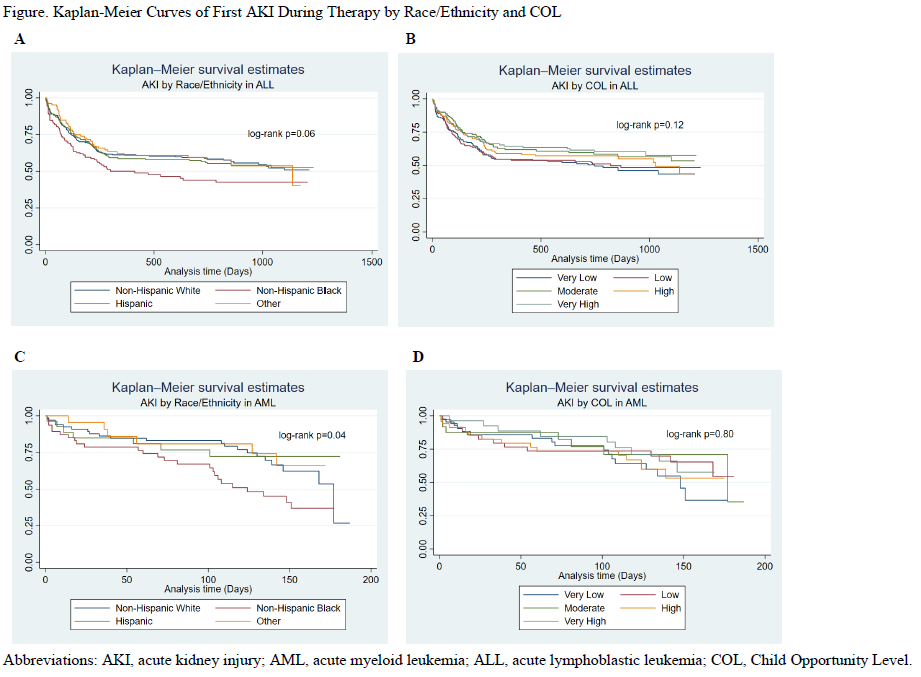Nephrology 4
Session: Nephrology 4
601 - Racial, Ethnic, and Neighborhood Disparities in Acute Kidney Injury in Pediatric Acute Leukemia
Sunday, April 27, 2025
8:30am - 10:45am HST
Publication Number: 601.6090
Wendy C. Bravo, Children's Hospital Los Angeles, Los Angeles, CA, United States; Yimei Li, University of Pennsylvania, Philadelphia, PA, United States; Tamara P.. Miller, Emory University School of Medicine, Atlanta, GA, United States; Kelly Getz, Perelman School of Medicine at the University of Pennsylvania, Phialdelphia, PA, United States; Lusha Cao, Childrens Hospital of Philadelphia, Philadelphia, PA, United States; Edward Krause, Childrens Hospital of Philadelphia, Philadelphia, PA, United States; Mark Ramos, Childrens Hospital of Philadelphia, Philadelphia, PA, United States; Maria Monica Gramatges, Baylor College of Medicine, Houston, TX, United States; Karen Rabin, Baylor College of Medicine, Houston, TX, United States; Michael E. Scheurer, Baylor College of Medicine, Houston, TX, United States; Richard Aplenc, Children's Hospital of Philadelphia, Philadelphia, PA, United States; Michelle Denburg, Children's Hospital of Philadelphia, Philadelphia, PA, United States

Wendy C. Bravo, MD, MSCE (she/her/hers)
Attending Physician, Assistant Professor of Clinical Pediatrics
Children's Hospital Los Angeles
Los Angeles, California, United States
Presenting Author(s)
Background: Acute kidney injury (AKI) may be associated with worse cancer and long-term kidney outcomes in children with acute leukemia.
Objective: We sought to identify racial, ethnic, and neighborhood disparities in AKI in children with acute lymphoblastic or myeloid leukemia (ALL, AML).
Design/Methods: Electronic health record data were retrospectively collected from pediatric patients treated for de novo ALL or AML (2010-2018) at three large cancer centers in the Leukemia Electronic Abstraction of Records Network (LEARN). Patients were followed from the time of first available information in LEARN (i.e., from the initial leukemia diagnosis admission or first chemotherapy course in LEARN) through upfront chemotherapy completion, death, relapse, conditioning for stem cell transplant, or transfer of care, whichever came first. AKI was defined according to modified Kidney Disease Improving Global Outcomes criteria. Neighborhood-level resources were determined with the Child Opportunity Level (COL). Prevalence ratios (PRs) for AKI at diagnosis by race/ethnicity and COL were calculated with modified Poisson regression. Cox proportional hazards regression was used to calculate hazard ratios (HRs) of first AKI after initiation of chemotherapy (i.e., "during therapy"). Kaplan-Meier curves were produced for first AKI during therapy by race/ethnicity and COL and compared with log-rank p-values.
Results: Approximately half of patients had AKI at diagnosis or during therapy (ALL: n=482/952, [50.6%], AML: n=77/168 [45.8%]). Non-Hispanic Black (NHB) patients with ALL had a significantly increased prevalence of AKI at leukemia diagnosis compared to Non-Hispanic White (NHW) patients in both unadjusted (PR 1.72) and adjusted models (PR 1.50), while there were no significant differences by COL. There were no significant differences in AKI at diagnosis by race/ethnicity or COL in AML. During ALL therapy, NHB patients had significantly higher hazard of AKI compared to NHW and those with Very High COL had significantly lower hazard of AKI compared to those with Very Low COL in unadjusted models, but not in adjusted models. During AML therapy, NHB patients had significantly higher risk of AKI in both unadjusted (HR 1.95) and adjusted (HR 2.85) models, but there were no differences by COL. There were no statistically significant differences in median follow-up time during therapy by race/ethnicity or COL in both cohorts (Table, Figure).
Conclusion(s): Racial/ethnic disparities are present in AKI risk in pediatric acute leukemia. Further studies to identify drivers of, and interventions for, AKI risk are needed.
Table: Unadjusted and Adjusted Prevalence Ratios of AKI at Diagnosis and Hazard Ratios of First AKI During Therapy in ALL and AML
.png)
Figure. Kaplan-Meier Curves of First AKI During Therapy by Race/Ethnicity and COL

Table: Unadjusted and Adjusted Prevalence Ratios of AKI at Diagnosis and Hazard Ratios of First AKI During Therapy in ALL and AML
.png)
Figure. Kaplan-Meier Curves of First AKI During Therapy by Race/Ethnicity and COL


